The Beauty of Traditional Chuong Village Leaf Hat
The old Chuong Village in Ha Noi always preserves the business of creating an authentic conical hat for Vietnamese. This conical hat can make Vietnamese women become much more lovely and attractive when put on the traditional cloth of "Ao dai". The special feature about the hats from Chuong village has attracted a lot of tourists coming and learning how to make one which become a beautiful and unique souvenir that many people want to own them.
Leaf hats in Chuong Village has long been famous for being firm, durable and good looking. The village is located in Thanh Oai district, Hanoi. From Ba La T-conjunction in Ha Dong district of Hanoi, you can arrive at the village after driving for around 15 kilometers. The Conical Hat Chuong Village is usually being called as "Lang Non Chuong" in Vietnamese (“Lang” means village, “Non” means hat), famous for the tradition of making leaf hat. Originated from the village, many types of the conical hat have been made, not only in different shapes but also in many different sizes such as the light Hue-styled conical hat, the white palm-leaf hat, the yellow hat, and also the small one for the soldier.
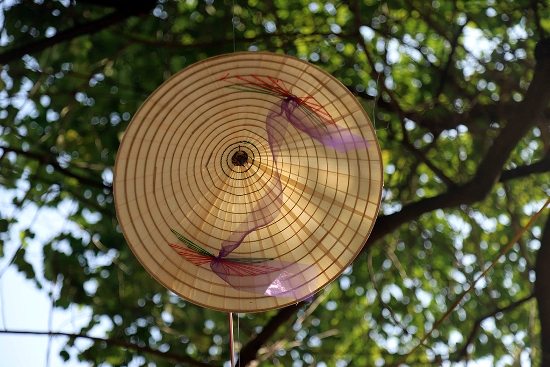
The Vietnamese conical leaf hat
There is a market that is located right on the foot of the dyke which is not only specializing in leaf hats. Every morning, various types of grocery are available for sale including vegetable and meat of all type. Only in the morning of 4th, 10th, 14th, 20th, 24th and 30th in every month, leaf hats and materials to make leaf hats are presented for sales at this market. On these days, the market welcomes visitors with the eye-catching color of various ingredients like wool strings and colorful fish net strings.
Another corner of this market is the space for bamboo strings which are made and gathered into large bunches. Bamboo strings are divided into 2 types with different colors of red and white. This is the major material to make ring hats. A “Non” in Chuong Village is made with total 16 rings in which 15 rings are tightened with white bamboo strings and the final ring outside is tightened with red strings. The main product always is the white leaf “Non” because this type of hat is easy to use in daily life. That is the reason why this beautiful white color has been covered the whole village, make an attractive look for the place and also the smell of resin has created a good scent spreading in the air.

They are selling "non" at Chuong Village's market
Chuong Village leaf hats look simple to make but it requires the makers to be careful and sophisticated from the process of choosing materials. The rings need to be flexible but also firm.
1. HOW TO MAKE A CHUONG CONICAL HAT
Step 1: Straighten the leaf
Dried palm leaves are the main material to make leaf hats. These eye-catching leaves in white and a little green are brought from the mountainous area in Thanh Hoa, Ha Tinh provinces. They are mixed with sand and dried under sunshine for 2 or 3 days until the color changes to silver. To keep the leaves flat and durable, they are also be pressed on hot plowshare by a clout. The leaf has to be pulled shortly under the heated plowshare to make it flat and cannot be broken.
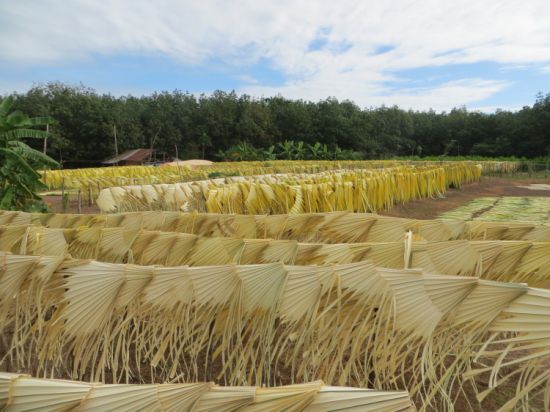
People dry the palm leaves under sunshine for 2 or 3 days until the color changes to silver.
Step 2: Rotate the hat
In this second step, the craftsman have to be very skillful to ensures the endurance of the hat, because it includes many smaller steps that they need to be careful to tie fishing lines around the bamboo frame, using leaves to insert throughout the frame, cover the leaves by using spathe, and then cover the spathe layer by using the leaves.
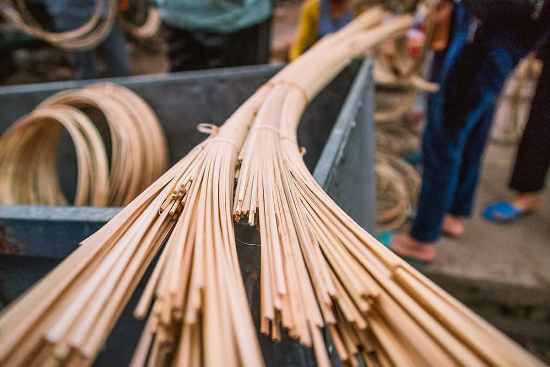
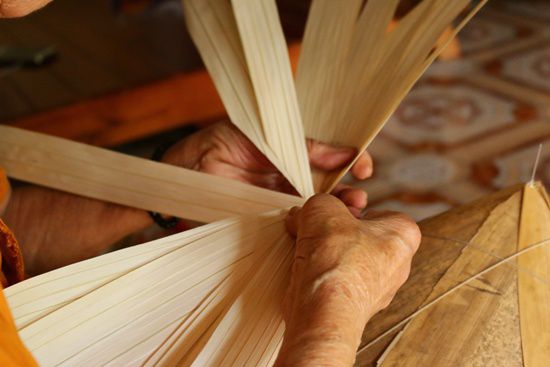
The materials to make a leaf hat
Step 3: Needle the hat
From the top to the largest prime, the craftsman has to needle the hat. Their skill will be present from each needle.
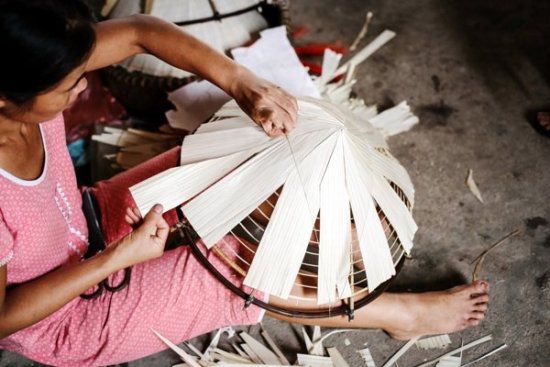
Needling the hat
Step 4: Finish the hat
The final step is needling the handles through the frame and using the rims and sub rims to keep it stable. Then, the makers will use the burning matches to make the hat more shining and to prevent it from getting musty.
Look at the hats in white both inside and outside faces, you may not know that it is in need of a layer of sheath from a bamboo – related trees in the middle to make the hats more rigid. There are only 2 or 3 people selling this kind of sheath at this market, so they often attract many buyers.
Different from the sellers for wool strings, bamboo strings or sheath, those who sell leaves do not have a fixed stall on the market. They gather in a group at the yard of the temple on the sunny day and when it rains, they move to the bell towel of the village to avoid getting wet and talk to each other merrily.
I met with an old man selling Lui leaves at this market. He is now above 80 years old, but every market fair comes, he carries a large bag of leaves on his bike and walks for above 1 km to arrive at the market. He said that he has been close to the job since he was a child and he will not stop doing the job until he could not be able to walk.
Chuong Village leaf hat market is crowded and busy but it will come to an end after around 3 hours. Leave hat market is opened 6 times a month, 72 times per year and that is the way to develop this traditional handcraft and make it famous locally and internationally. Waking up in a summer morning, the busy space of a village fair shall be an interesting suggestion for many tourists, and Chuong Village Leaf Hat Market is one of the interesting destinations.
2. THE VARIED VIETNAMESE CONICAL HAT IN CHUONG VILLAGE

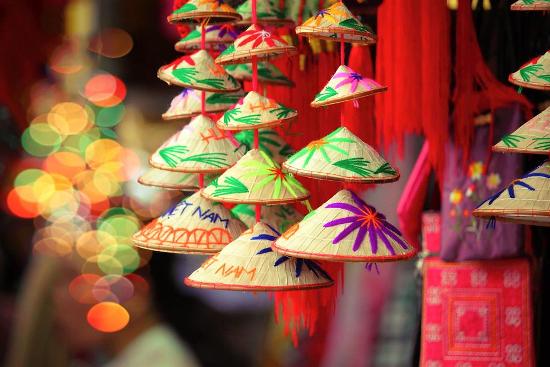
"Non" is upgraded with colorful details
Not only local guests but also foreign visitors often come and take a trip to Chuong village. They will come to buy some lovely souvenirs and take a look at the process of how they can make a Vietnamese conical hat in traditional way. Chuong conical hat along with the Vietnamese Ao dai are having various types to make the best combination with the beautiful dresses now.
related destinations
Hanoi Street Artworks: Phung Hung Murals and Ceramic Mosaic Murals
With nowadays hustle and bustle life, Hanoi is known as a destination of old, peaceful, and profound beauty....Top 4 Resorts with Playground for Kids nearby Hanoi City Center
The hustle and bustle life of people who lives in big cities leading to the demand of relaxation and...The Temple of Literature - The first University of Thang Long Capital
Undergo over 1000 years of history, the Temple of Literature still be retained ancient beauty with...(+84) 3 87 86 68 52
Testimonials
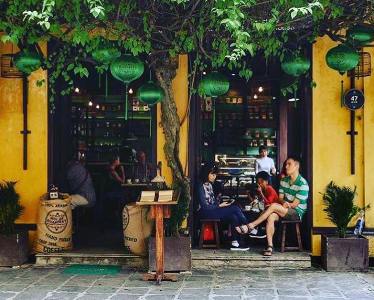
Excellent arrange, a really adapted proposal to our request
We were a group of 3 couples, chose FarEastour for our trip in Vietnam. We had some wishes:...
Highly recommended travel agency
We are very happy with our 22 days trip organized by Far East Tour! Our travel consultant,...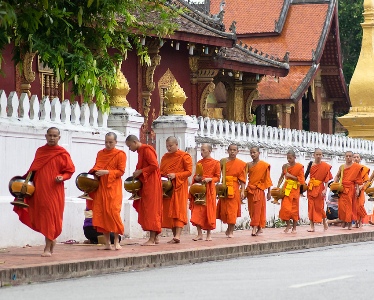
Dear Esther, I had a great time in Asia! You did arrange everything so perfect. Thank you so...

Touch with you again and remembering our unforgettable trip
Dear Christine, Hello, is good getting in touch with you again and remembering our unforgettable...
We had a very pleasant tour on Douce Mekong
Dear Wind, Thank you once again for your assistance, we had a very pleasant tour on Douce...
The trip to Ha Long Bay exceeded my expectations
Morning Esther, Now that I have returned to Australia I just wanted to send you a quick...
My trip to Sapa with your company has been great
Thanks a lot for your collaboration. About my trip to Sapa with your company has been great. The...
13 Days From Hanoi to Mekong with lots of happiness
We have been very happy having Mr Cong as a guide for Hanoi, and our cruise in Halong Bay was...
We asked Far East to put together a tour of Vietnam from north to south. They promptly emailed a...

Very professional and experienced travel agent
Very friendly and professional travel agent. Good advice given on what type of journey suits you....
I recommended your company to our travel agent in Germany
Dear Christine, Everything was fine, also the food. And for the vegetarian they tried special... Vietnam Tours
Vietnam Tours Vietnam Touren
Vietnam Touren Voyage au Vietnam
Voyage au Vietnam 越南旅游
越南旅游 越南旅遊
越南旅遊





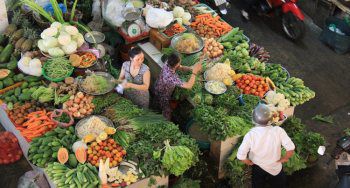

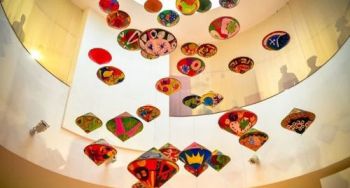





24/7